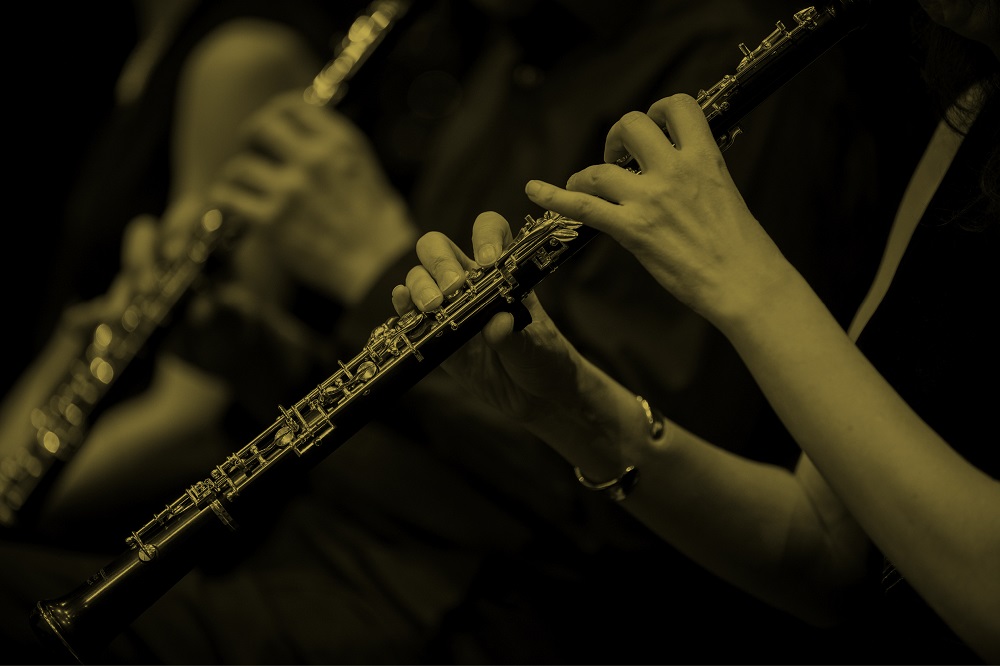Scottish Chamber Orchestra, Queen's Hall, Edinburgh online review – two Parisian gems | reviews, news & interviews
Scottish Chamber Orchestra, Queen's Hall, Edinburgh online review – two Parisian gems
Scottish Chamber Orchestra, Queen's Hall, Edinburgh online review – two Parisian gems
Salon music – but only from your own salon

Though live performances are, thankfully, starting to reappear throughout the country, and socially distanced seating, mask-donning and constant hand sanitising becomes the norm for audiences south of the border, those in Scotland are still eagerly anticipating the opportunity to once again be in a concert hall experiencing live music first hand.
SCO flautist André Cebrián introduced the Poulenc, describing it as ‘an exciting trip to the cafes, cabarets and jazz clubs of Paris of the ‘30s, with plenty of humour and irony.’ Motifs inspired by music halls and circuses abound, and the rambunctious spirit of the piece was evident from the very first chord. Clarinettist Maximiliano Martin’s pithy, punchy passages in the first movement were beautifully matched with more delicate playing from Cebrián on flute, and Alison Green on bassoon. As the music grew warmer and only slightly less irreverent, Cebrián’s feathery flutter-tonguing was well balanced with delicate keyboard playing from Simon Smith. The raucous fun soon resumed, as the movement ended with a stylish flourish.
The middle movement takes on a more reserved style, with much heavily borrowed from Mozart, but given Poulenc’s witty twist. The players perfectly capture the music’s mood, with a few cheeky nods offsetting its apparent tranquillity. The prestissimo finale had a spiky, boisterous opening, though its more ponderous end section perhaps stood out more, with each players’ lines beautifully melting into one-another, culminating in a surprisingly elegant ending.  Moving on to another Parisian composer, Louise Farrenc, the winds were joined on stage by one of each orchestral string instrument for what Cebrián – who also introduced this work – described as a "symphony in miniature".. Indeed, despite being scored for only nine players, Farrenc’s nonet is a vividly detailed musical canvas brimming with colour, with the group onstage producing a full sound which belied their number. Playing with innate synchronicity, the piece began with marked, stiking string chords punctuated by delicate woodwinds. The first movement – and the work’s longest – was played with a mature poise, with beautiful singing passages from violinist Kana Kawashima.
Moving on to another Parisian composer, Louise Farrenc, the winds were joined on stage by one of each orchestral string instrument for what Cebrián – who also introduced this work – described as a "symphony in miniature".. Indeed, despite being scored for only nine players, Farrenc’s nonet is a vividly detailed musical canvas brimming with colour, with the group onstage producing a full sound which belied their number. Playing with innate synchronicity, the piece began with marked, stiking string chords punctuated by delicate woodwinds. The first movement – and the work’s longest – was played with a mature poise, with beautiful singing passages from violinist Kana Kawashima.
The Andante con moto certainly had a fair bit of movement, though the overall pace felt relaxed, with flurried movements in the winds balanced by more leisurely strings, and vice-versa. The third, scherzo movement, had an energy so infectious I momentarily forgot I was only seeing the musicians via a screen. The violin's and cello’s pizzicato gave the movement’s opening minor bars a stealthy edge, before the music took a resplendent shift to major. The continuous shifts between major and minor were executed with zest and vigour, before the more reverent finale, which was played with poise, gravity and depth.
While of course the regulations in Scotland surrounding live performance make things difficult, both practically and emotionally, for performers, managers, critics and audience alike, it was still a treat to hear this salon-style music played live, in the comfort of my own salon, and to see the Queen’s Hall filled with music once more.
rating
Explore topics
Share this article
The future of Arts Journalism
You can stop theartsdesk.com closing!
We urgently need financing to survive. Our fundraising drive has thus far raised £49,000 but we need to reach £100,000 or we will be forced to close. Please contribute here: https://gofund.me/c3f6033d
And if you can forward this information to anyone who might assist, we’d be grateful.

Subscribe to theartsdesk.com
Thank you for continuing to read our work on theartsdesk.com. For unlimited access to every article in its entirety, including our archive of more than 15,000 pieces, we're asking for £5 per month or £40 per year. We feel it's a very good deal, and hope you do too.
To take a subscription now simply click here.
And if you're looking for that extra gift for a friend or family member, why not treat them to a theartsdesk.com gift subscription?
more Classical music
 Kohout, Spence, Braun, Manchester Camerata, Huth, RNCM, Manchester review - joy, insight, imagination and unanimity
Celebration of the past with stars of the future at the Royal Northern College
Kohout, Spence, Braun, Manchester Camerata, Huth, RNCM, Manchester review - joy, insight, imagination and unanimity
Celebration of the past with stars of the future at the Royal Northern College
 Jansen, LSO, Pappano, Barbican review - profound and bracing emotional workouts
Great soloist, conductor and orchestra take Britten and Shostakovich to the edge
Jansen, LSO, Pappano, Barbican review - profound and bracing emotional workouts
Great soloist, conductor and orchestra take Britten and Shostakovich to the edge
 Jakub Hrůša and Friends in Concert, Royal Opera review - fleshcreep in two uneven halves
Bartók kept short, and a sprawling Dvořák choral ballad done as well as it could be
Jakub Hrůša and Friends in Concert, Royal Opera review - fleshcreep in two uneven halves
Bartók kept short, and a sprawling Dvořák choral ballad done as well as it could be
 Hadelich, BBC Philharmonic, Storgårds, Bridgewater Hall, Manchester review - youth, fate and pain
Prokofiev in the hands of a fine violinist has surely never sounded better
Hadelich, BBC Philharmonic, Storgårds, Bridgewater Hall, Manchester review - youth, fate and pain
Prokofiev in the hands of a fine violinist has surely never sounded better
 Monteverdi Choir, ORR, Heras-Casado, St Martin-in-the-Fields review - flames of joy and sorrow
First-rate soloists, choir and orchestra unite in a blazing Mozart Requiem
Monteverdi Choir, ORR, Heras-Casado, St Martin-in-the-Fields review - flames of joy and sorrow
First-rate soloists, choir and orchestra unite in a blazing Mozart Requiem
 Cho, LSO, Pappano, Barbican review - finely-focused stormy weather
Chameleonic Seong-Jin Cho is a match for the fine-tuning of the LSO’s Chief Conductor
Cho, LSO, Pappano, Barbican review - finely-focused stormy weather
Chameleonic Seong-Jin Cho is a match for the fine-tuning of the LSO’s Chief Conductor
 Classical CDs: Shrouds, silhouettes and superstition
Cello concertos, choral collections and a stunning tribute to a contemporary giant
Classical CDs: Shrouds, silhouettes and superstition
Cello concertos, choral collections and a stunning tribute to a contemporary giant
 Appl, Levickis, Wigmore Hall review - fun to the fore in cabaret and show songs
A relaxed evening of light-hearted fare, with the accordion offering unusual colours
Appl, Levickis, Wigmore Hall review - fun to the fore in cabaret and show songs
A relaxed evening of light-hearted fare, with the accordion offering unusual colours
 Lammermuir Festival 2025, Part 2 review - from the soaringly sublime to the zoologically ridiculous
Bigger than ever, and the quality remains astonishingly high
Lammermuir Festival 2025, Part 2 review - from the soaringly sublime to the zoologically ridiculous
Bigger than ever, and the quality remains astonishingly high
 BBC Proms: Ehnes, Sinfonia of London, Wilson review - aspects of love
Sensuous Ravel, and bittersweet Bernstein, on an amorous evening
BBC Proms: Ehnes, Sinfonia of London, Wilson review - aspects of love
Sensuous Ravel, and bittersweet Bernstein, on an amorous evening
 Presteigne Festival 2025 review - new music is centre stage in the Welsh Marches
Music by 30 living composers, with Eleanor Alberga topping the bill
Presteigne Festival 2025 review - new music is centre stage in the Welsh Marches
Music by 30 living composers, with Eleanor Alberga topping the bill
 Lammermuir Festival 2025 review - music with soul from the heart of East Lothian
Baroque splendour, and chamber-ensemble drama, amid history-haunted lands
Lammermuir Festival 2025 review - music with soul from the heart of East Lothian
Baroque splendour, and chamber-ensemble drama, amid history-haunted lands

Add comment